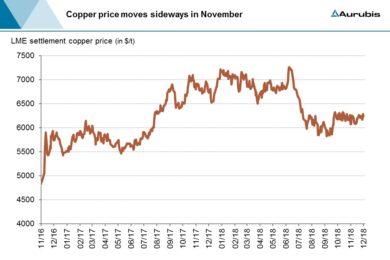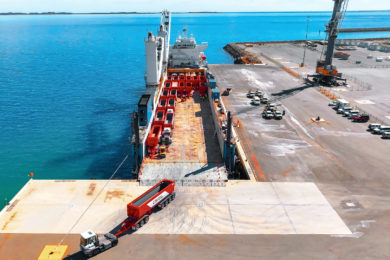Aurubis reports that “following LME Week in October, the copper world met up again in November, this time in Shanghai. Well-known mining companies used this as an opportunity to communicate upcoming investments in mine expansions. The signs in Chile continue to point to growth in 2019: The consulting company Fitch Solutions forecasts 4 % growth thanks to a lower risk of strikes, as well as mining companies’ efforts to improve the quality of their mines.”
The International Monetary Fund (IMF) adjusted its economic outlook in October and was followed by the Organization for Economic Cooperation and Development (OECD), which issued its economic forecast in November. The OECD expects gross domestic product worldwide to increase by 3.7 % in the current year. For 2019 and 2020, the organization has reduced its forecast by 0.2 percentage points, to 3.5 % in both years. The key reason cited for this change is the simmering trade dispute between the US and China and the resulting uncertainties.
For the US, the organization anticipates 2.9 % growth in the current year. Expected growth for 2019 and 2020 is 2.7 % and 2.1 %, respectively. For China, the OECD sees a growth rate of 6.6 % for this year and 6.3 % for next year. The expectation for 2020 is 6.0 %. When it comes to the euro zone, the organization adjusted its forecast for the current year downward, to 1.9 %, and anticipates a further reduction to 1.8 % in the coming year and 1.6 % in 2020. The OECD expects gross domestic product of 1.6 % in Germany in the current and upcoming year. Growth of 1.4 % is expected for 2020.
The US dollar was at about US$ 1.14 in relation to the euro at the close of November and was thus at the level of October.
According to ICSG calculations, the copper market remained balanced in August, with a minimal refined copper deficit of about 31,000 t (July: 84,000 t). Looking at the first eight months of 2018, there was a deficit of around 259,000 t (8M 2017: deficit of 98,000 t). Global refined copper output of 1.96 Mt in August came up against global demand of 1.99 Mt, as the ICSG reported.
According to Reuters, Chile produced 4.25 Mt of copper in the first nine months of 2018, or 7 % more copper than in the first nine months of 2017. One reason was the high output coming fromBHP’s Escondida mine until September. Its output was approximately 60 % higher than last year, since the mine produced less in 2017 due to strikes. Moreover, Chile’s second-largest mine, Collahuasi, boosted its production by 5.8 % YOY, to 401,000 t. The signs point to growth in Chile for 2019 as well: The consulting company Fitch Solutions forecasts 4 % growth for next year. Fitch states that the reason is a lower risk of strikes, as well as mining companies’ efforts to improve the quality of their mines.
Copper production in Peru, the world’s second largest copper raw material supplier, declined in September and October. Compared to September 2017, output fell by 19 % to 202,000 t in September 2018, as S&P Global Platts reported. In October 2018, too, copper output was about 4 % below October 2017, according to Bloomberg.
Anglo American discussed its future copper output in an interview with Bloomberg. The company confirmed or increased its production forecast for the next three years. Output should be 660,000 t in 2018, between 630,000 and 660,000 t in 2019, and between 620,000 and 680,000 t in 2020. Anglo expects production in its Quellaveco mine in Peru to ramp up in 2022. In the medium term, the company plans to produce more than 1 Mt of copper.
Antofagasta also commented on its future production during Asia Copper Week in Shanghai, in the context of an interview with Metal Bulletin. The company expects a record output between 750,000 and 790,000 t, a leap of about 8 % compared to 2018. The primary reason for the increase is the high-quality ore deposits of the Centinela mine. The copper contents of the deposits are higher than previously expected, according to the company’s remarks.
In November, Antofagasta also made the decision to expand Los Pelambres mine in Chile. The project requires an investment of $ 1.3 billion, and the concentrates should add around 60,000 t of refined copper to the global market over a period of 15 years. Expanding Los Pelambres will raise the processing capacity from 175,000 to 190,000 t/d of ore and increase Antofagasta’s output by roughly 15%. As Reuters reported, construction work will start in January 2019 and is expected to conclude by 2021.
Reuters also stated that Birla Copper, one of the largest copper producers in India, expects Indian demand for refined copper to double in the next eight years. Demand should increase to about 1.4 Mt until 2026, from 0.65 Mt in 2018. Taking stronger demand due to electric vehicles into account, the company could even imagine a demand level of 2.5 Mt.
The copper price on the London Metal Exchange (LME cash settlement) rose slightly in early November, then moved sideways around the $6,200/t mark starting in the middle of the month. Positive fundamental data from China supported this trend.
The Chilean state news agency Cochilco slightly adjusted its copper price downward, to $6,548/t for 2018. The copper price for 2019 should average $6,724/t. The investment bank Macquarie reported that Cochilco cited the trade conflicts between the US and China as the reason behind this reduction.
The smelter industry’s copper concentrate supply situation remained very good in November. Spot treatment and refining charges for copper concentrates (TC/RCs) were again between $ 93/t and $96/t, according to Fastmarkets. In the meantime, levels in the triple digits have even been reported. Chinese smelters are reportedly still well supplied with concentrates.
Jiangxi Copper and Antofagasta agreed on TC/RCs of $80.80/t for 2019, according to Reuters. This news is surprising in light of the significantly higher spot prices on the concentrate market at the moment, the good overall concentrate supply situation in 2018 due to high mine output, and the smelter downtimes scheduled for 2019. On top of that, not much has been revealed up to now regarding the circumstances under which this price level was agreed on.
As Reuters reported, BHP’s Spence has been producing normally again after being briefly affected by strikes in November. The striking workers complained of a sub-par safety situation. BHP is planning to invest $2.5 billion at the site to extend the mine’s lifetime by another 50 years. The expansion should lead to a higher output in 2021.
Bloomberg reported that US exporters sold about 75 % more copper scrap to countries apart from China during the current year. China had been the biggest purchaser of copper scrap from the US in the past. Export data from Reuters indicates that imports of copper scrap from US to China fell by 37% between September and October, to 6,065 t. This is less than one-sixth of the import volume of October 2017. In October 2018, the US accounted for just 2.5 % of copper scrap imports in China, compared to 22.3 % in January 2018.
The decline in Chinese imports from the US are mainly attributed to two key influences, according to CRU: For one, China has imposed a 25 % import duty on US scrap since August. Furthermore, an import ban for copper scrap with high impurity levels (called category 7 scrap) will go into effect in 2019. S&P Global Platts states that the latter factor in particular has supposedly led to a roughly 250,000 t (copper content) decrease in Chinese copper scrap imports of this quality due to preliminary impacts. A similar drop in volume is also expected for 2019.
According to Reuters, Vedanta has started selling copper concentrates from the inventories of the Indian smelter Tuticorin, which is currently out of commission. So far, about 70,000 t of concentrates have been offered on the market.
As Reuters reported, the Japanese company Mitsubishi Materials declared force majeure for its Indonesian copper smelter PT Smelting, since it can’t fulfill some of its customers’ orders due to prolonged maintenance work. The work had to be extended because a neighboring oxygen plant had to prolong its own maintenance period and wasn’t delivering oxygen to PT Smelting. As a result, the company expects a cathode production loss of about 20,000 t. The plan is to restart the smelter in mid-December.
Inventories in the world’s warehouses were lower again in November compared to the previous month. While deliveries to the LME warehouses jumped once more at the end of October, there were significant declines in November. In total, inventories fell by approximately 40,000 t in November and were at 402,000 t at the end of the month (end of October: around 445,000 t).










